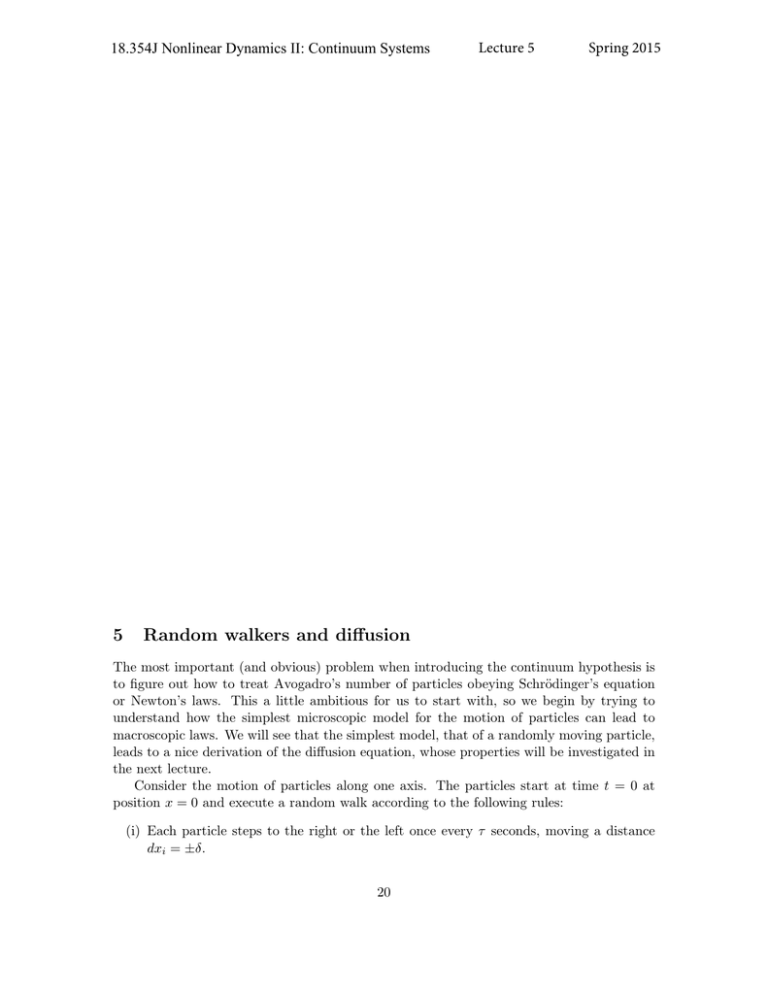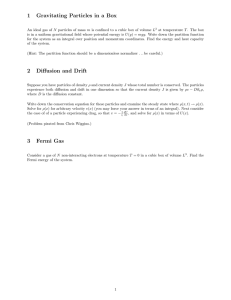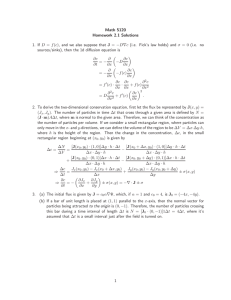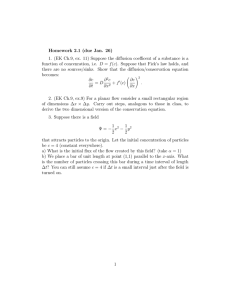5 Random walkers and diffusion Lecture 5 Spring 2015
advertisement

18.354J Nonlinear Dynamics II: Continuum Systems 5 Lecture 5 Spring 2015 Random walkers and diffusion The most important (and obvious) problem when introducing the continuum hypothesis is to figure out how to treat Avogadro’s number of particles obeying Schrödinger’s equation or Newton’s laws. This a little ambitious for us to start with, so we begin by trying to understand how the simplest microscopic model for the motion of particles can lead to macroscopic laws. We will see that the simplest model, that of a randomly moving particle, leads to a nice derivation of the diffusion equation, whose properties will be investigated in the next lecture. Consider the motion of particles along one axis. The particles start at time t = 0 at position x = 0 and execute a random walk according to the following rules: (i) Each particle steps to the right or the left once every τ seconds, moving a distance dxi = ±δ. 20 (ii) The probability of going to the right at each step is 1/2, and the probability of going to the left is 1/2, independently of the previous history. (iii) Each particle moves independently of all the other particles, i.e. the particles do not interact with one another. There are two striking consequences of these rules. Let N be the total number of particles and xi (n) be the position of the ith particle after n steps, and denote the average position of all particles by N 1 X X(n) = xi (n). (81) N i=1 The mean displacement of the particles after n steps is hX(n)i = = = = N 1 X hxi (n)i N 1 N 1 N 1 N i=1 N X [hxi (n − 1)i + hdxi i] i=1 N X i=1 N X 1 1 hxi (n − 1)i + δ · + (−δ) · 2 2 hxi (n − 1)i i=1 = hX(n − 1)i. (82) Thus particles go nowhere on average. Secondly, assuming that the all particles start at xi (0) = 0, the root-mean-square displacement of the particles, which is a good measure of spreading, is obtained as follows: h[X(n) − X(0)]2 i = hX(n)2 i *" #" #+ N N 1 X 1 X = xk (n) xi (n) N N = = 1 N2 1 N2 i=1 N N XX k=1 hxi (n)xk (n)i i=1 k=1 N X hxi (n)2 i, (83) i=1 where we have used that, by virtue of assumption (iii), hxi (n)xk (n)i = hxi (n)ihxk (n)i = 0 21 for i 6= k. The mean-square displacement per particle can be calculated from hxi (n)2 i = h[xi (n − 1) + dxi ]2 i = hxi (n − 1)2 i + 2hxi−1 (n) dxi i + hdx2i i = hxi (n − 1)2 i + 2hxi−1 (n)ihdxi i + δ 2 = hxi (n − 1)2 i + δ 2 . (84) Repeating this procedure n times and recalling that xi (0) = 0, we find hxi (n)2 i = hxi (0)2 i + nδ 2 = nδ 2 (85) and, hence, for the mean square displacement of the cloud’s mean value hX(n)2 i = N 1 X 2 δ2 n. nδ = N N2 (86) i=1 If we write n in terms of time such that t = nτ , where τ is the time in between each step, then 2 12 2 12 1 p √ δ t δ t 2 2 δ= = hxi (n) i = t. (87) τ τ τ The root-mean-square displacement of each particle is proportional to the square-root of the time. We now seek to derive a theory to predict the distribution of a cloud of random walkers at some time t given the distribution at t = 0. There are two ways to do so, one using particle fluxes and the other adopting a probabilistic approach. 5.1 Derivation of the diffusion equation using particle fluxes Consider two neighbouring points on a line. At time t there are N (x, t) particles at x and N (x + δ, t) particles at position x + δ. At time t + τ half the particles at x will have stepped across the dashed line from left to right and half of the particles at x + δ will have stepped across the dashed line from right to left. The net number of particles crossing to the right is therefore 1 − [N (x + δ, t) − N (x, t)] . (88) 2 To obtain the net flux, we divide by the area normal to the x-axis, A, and by the time interval τ , [N (x + δ, t) − N (x, t)] Jx = − . (89) 2Aτ Multiplying by δ 2 /δ 2 gives δ 2 1 N (x + δ, t) − N (x, t) Jx = − , (90) 2τ δ Aδ which can be rewritten Jx = −D n(x + δ, t) − n(x, t) , δ 22 (91) where D = δ 2 /2τ is the diffusion coefficient and n(x, t) = N (x, t) Aδ is the particle density (i.e., the number of particles per unit volume at position x at time t). If δ is assumed to be very small, then in the limit δ → 0, the flux becomes Jx = −D ∂n , ∂x (92) where we have ignored higher-order derivatives in making the approximation. Now consider a single box with boundaries at x − δ/2 and x + δ/2. In a single time step, Jx (x − δ/2, t)Aτ particles will enter from the left and Jx (x + δ/2, t)Aτ particles will leave through the right boundary. The number of particles in the box increases as follows, N (x, t + τ ) − N (x, t) = [Jx (x − δ/2, t) − Jx (x + δ/2, t)] Aτ. By dividing both sides by Aδτ the number of particles per unit volume in the box n(x, t) is seen to increase at the rate2 n(x, t + τ ) − n(x, t) τ = − [Jx (x + δ/2, t) − Jx (x − δ/2, t)] . δ (93) In the limit τ → 0 and δ → 0, this becomes ∂n ∂Jx ∂2n =− = D 2, ∂x ∂t ∂x (94) which is Fick’s law. This is commonly known as the diffusion equation. It tells us how a cloud of particles will redistribute itself in time. If we know the initial distribution and the boundary conditions, we can figure out all later distributions. It can be used to model many things, such as the spreading of dye in water, the transport of heat in solids, and the motion of bacteria. 5.2 Derivation using probabilities Before going on to solve the diffusion equation, let us derive the diffusion equation using a different approach, involving probabilities. Assuming non-interacting particles, the number of particles in the interval [x − δ/2, x + δ/2] at any given time is N (x, t) = N0 P (x, t) = N0 p(x, t)δ, (95) where N0 is the total number of particles in the sample, P (x, t) = p(x, t)δ the probability of finding the particle at time t in [x − δ/2, x + δ/2] and p(x, t) the associated probability density. If we consider discrete changes in position and time, then for particles that move to the left or right with equal probability P (x, t + τ ) = 2 1 [P (x + δ, t) + P (x − δ, t)] , 2 (96) For strictly one-dimensional systems, the boundary area is just a point and, hence, A = 1 in this case. 23 where the size of the time step is τ and the spatial separation is δ. Upon dividing by δ, we can rewrite (96) in terms of the associated probability density p(x, t + τ ) = 1 [p(x + δ, t) + p(x − δ, t)] . 2 (97) Performing a Taylor expansion about the position x and time t in the limit δ, τ → 0, ∂p ∂p 1 ∂ 2p δ2 ∂p ∂ 2p δ2 p(x, t) + p(x, t) + . (98) τ≈ δ+ 2 + p(x, t) − δ+ 2 2 ∂t ∂x ∂x 2 ∂x ∂x 2 which simplifies to the diffusion equation for the probability density ∂p ∂2p ≈ D 2, ∂t ∂x D= δ2 . 2τ (99) To recover Eq. (94), we note that the number density of particles is given by n = N0 p, and our derivation is complete. Note that we have ignored higher-order terms in the Taylor expansion. Additional terms would give us ∂p τ ∂ 2 p δ2 ∂ 2p δ4 ∂ 4p + ≈ − . (100) 2 2 ∂t 2 ∂t 2τ ∂x 4!τ ∂x4 Are we allowed to ignore these extra terms? To see if we are, compare the ratio of the neglected terms on the right hand side δ4 ∂ 4p δ2 ∂ 2p . (101) τ ∂x4 τ ∂x2 Now ∂p/∂x is essentially ∆p/∆x, where ∆p is a characteristic change in the value of p and ∆x is the characteristic length over which it changes. Let ∆p = P and ∆x = L; the ratio of the two terms is 2 2 δ4 P δ P δ , (102) ∼O 4 2 L τ L τ L which is typically very small. This is an example of a scaling argument, which in this case implies that we are justified in neglecting the extra terms provided L is much greater than δ. You must be careful however, as this estimate is not correct everywhere. For example, in the tails of the distribution the characteristic lengthscale over which there is a change in p may become important. The argument of neglecting terms is therefore not always valid, and we shall discuss this point more when we encounter singular perturbations later in the course. The discovery of this issue and its resolution was probably the greatest achievement of applied mathematics in the twentieth century. 5.3 Suggestions For an excellent read on random walkers and the diffusion equation, and their applications in biology, have a look at Random Walks in Biology by Howard C. Berg (a professor over at Harvard). In this book, the ideas we have discussed are applied to a number of biological phenomena, including the motion of bacteria (which would make a good course project). 24 MIT OpenCourseWare http://ocw.mit.edu 18.354J / 1.062J / 12.207J Nonlinear Dynamics II: Continuum Systems Spring 2015 For information about citing these materials or our Terms of Use, visit: http://ocw.mit.edu/terms.






